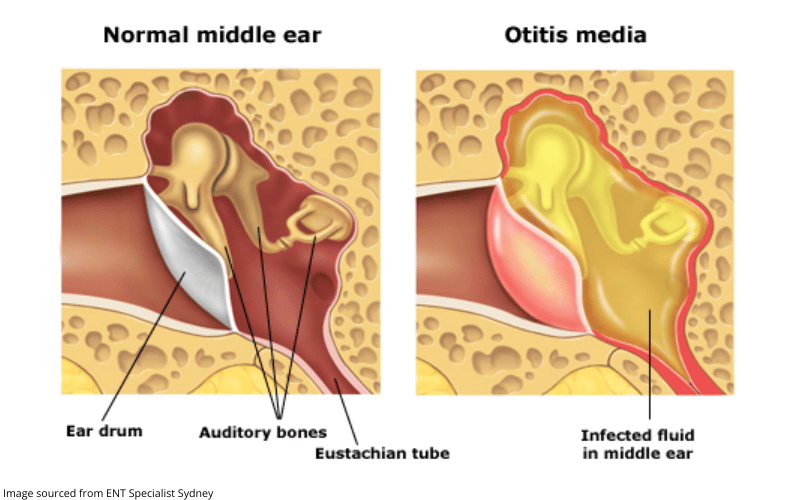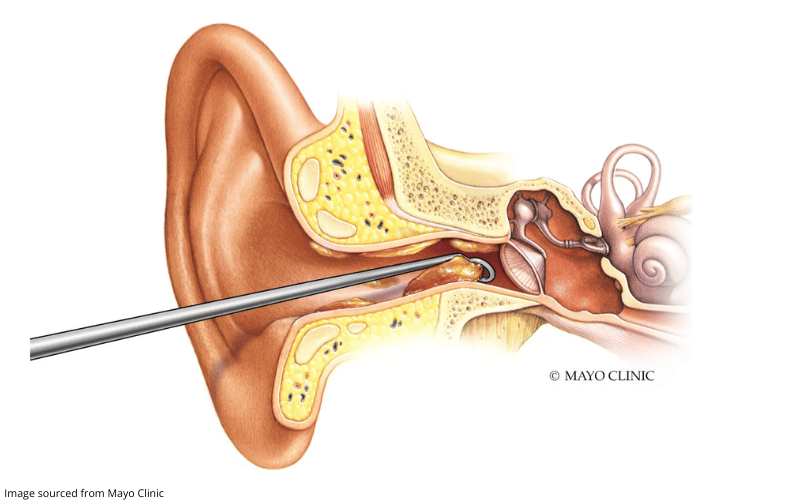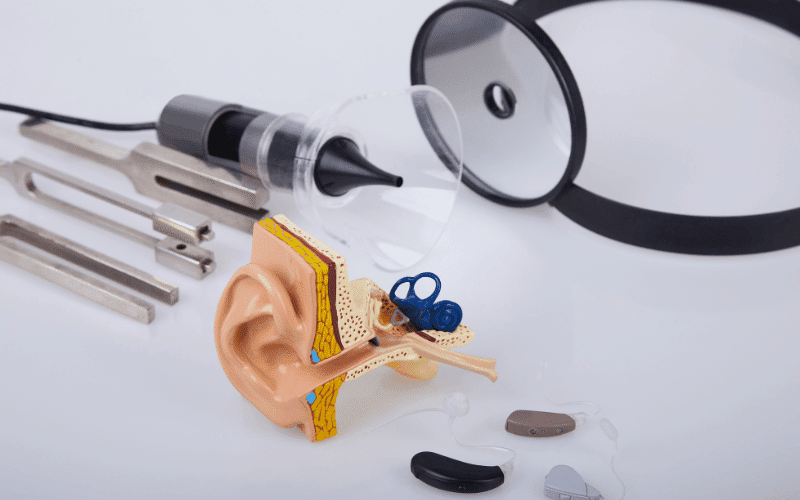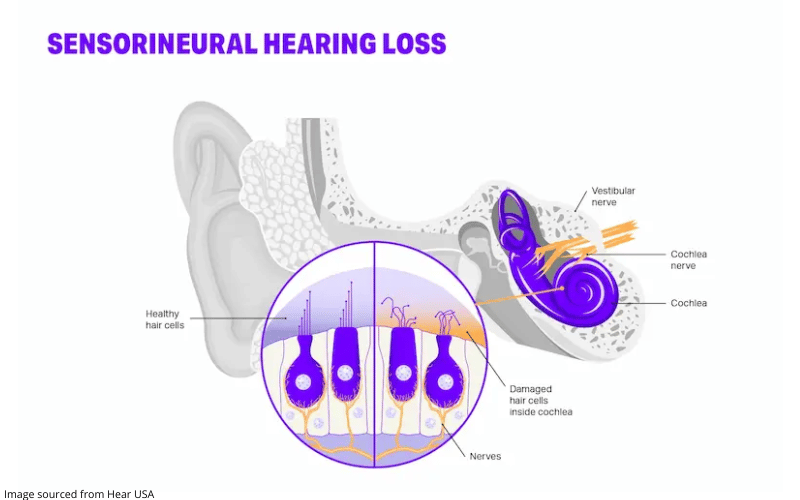When discussing hearing loss, a variety of terms often come into play, which can often be overwhelming at first. However, it’s important to understand that hearing loss isn’t a singular condition; it encompasses various types and degrees of severity. The types of hearing loss include sensorineural, conductive, or mixed, and can range from mild to severe. Hearing loss may affect one or both ears and can develop gradually or suddenly. Understanding the differences between different kinds of hearing loss is crucial, as it aids in accurately diagnosing and treating the condition, whether it affects you or someone close to you.
To grasp the complexities of hearing loss, it’s essential to begin with a fundamental understanding of the ear’s anatomy and the process of sound perception. Given that all variations and degrees of hearing loss are intrinsically linked to ear function, let’s embark on a brief anatomical journey.
Anatomy Of The Ear


Despite its small size, the ear is an intricately designed organ, essential for our auditory perception. It consists of three primary sections: the outer ear, the middle ear, and the inner ear, each playing a vital role in how we interpret and understand sounds.
The Outer Ear
The outer ear consists of visible external parts, notably the pinna, and structures observable through an otoscope (a tool doctors use during physical exams), such as the ear canal and the tympanic membrane, more commonly known as the eardrum.
The Middle Ear
The tympanic membrane, or eardrum, serves as a boundary between the outer and middle ear, thus belonging to both regions. The middle ear extends beyond the eardrum, encompassing the ossicles (tiny bones within the ear), the middle ear cavity, the stapedius and tensor tympani muscles, and the eustachian tubes.
The stapedius and tensor tympani muscles are crucial for the acoustic reflex, a protective response that contracts these muscles in reaction to loud or high-pitched sounds, safeguarding the inner ear cells. The eustachian tubes, conversely, are tasked with regulating pressure and draining fluid in the middle ear.
The Inner Ear
The inner ear, or the cochlea, comprises cochlear hair cells, auditory nerve endings, semicircular canals, and other support cells. The cochlear hair cells transform mechanical vibrations from sound waves into electrical signals, which are then transmitted to the brain by auditory nerve endings. The semicircular canals, filled with fluid, are instrumental in maintaining balance.
How We Hear
Having outlined the ear’s anatomical structures, let’s review how they collectively facilitate hearing.
Sound enters through the pinna into the ear canal, causing the eardrum to vibrate. These vibrations are then relayed to the three ossicles in the middle ear, amplifying them before they reach the inner ear. Here, the cochlear hair cells convert these vibrations into electrical signals, which are sent to the brain via the auditory nerve. The brain interprets these signals as recognizable sounds.
Hearing is thus a complex, multi-step process. Any deviation in this intricate system can result in hearing loss, with the type of hearing loss depending on the specific part of the process that is disrupted.
What Is Conductive Hearing Loss?



Conductive hearing loss occurs when sound transmission through the outer or middle ear is obstructed due to a physical barrier, such as fluid accumulation.
As we discussed above, sound travels as air vibrations through the ear canal, vibrates the eardrum, and is then carried through the middle ear by the ossicles to the inner ear, where the cochlea and auditory nerve process these sounds.
When a physical obstruction in the outer or middle ear interferes with the transmission of these sound vibrations, there’s a reduction in the amplification of sound. By the time the sound reaches the inner ear for processing, it’s significantly quieter than its original source – resulting in conductive hearing loss.
Causes Of Conductive Hearing Loss
Conductive hearing loss can arise from a variety of issues affecting the outer and middle ear, including:
Fluid Accumulation
Seasonal allergies and common colds can lead to an excess buildup of fluid in the middle ear. This fluid not only creates a sensation of fullness in the ears but also impairs hearing, contributing to conductive hearing loss.
Typically, this fluid is watery (referred to as “serous”) and does not usually lead to infection. However, it can cause symptoms like ear popping, pain, the aforementioned fullness, and hearing loss.
Ear Infections
Ear infections are another prevalent cause of conductive hearing loss. There are two primary types to consider: otitis media, which affects the middle ear, and otitis externa, impacting the outer ear.



Otitis Media
Otitis Media occurs when abnormal fluid accumulates in the middle ear, which ideally should contain air to properly conduct sound. This condition often arises alongside upper respiratory infections, allergies, colds, flu, and sinus infections, leading to eustachian tube blockage due to swelling of surrounding tissues, and consequently, fluid build-up in the middle ear.
This fluid accumulation creates an ideal environment for bacterial growth, leading to infections like otitis media. This type of infection varies in severity and is more common in young children and babies, due to the distinct shape and orientation of their eustachian tubes.
While otitis media and fluid accumulation might seem similar, a key difference is that in otitis media, the fluid is often thicker due to its infectious nature, unlike the watery fluid typically associated with allergies.
Otitis Externa
Commonly known as Swimmer’s Ear, otitis externa is an infection in the outer ear canal, usually caused by bacteria thriving in residual water left in the ear after swimming. This condition can significantly reduce sound transmission if the inflammation is severe.
Eustachian Tube Dysfunction
The eustachian tube connects the middle ear to the nose and throat, and is crucial for maintaining equal air pressure. When this tube malfunctions, possibly due to infection, it fails to drain fluid from the air-filled middle ear cavity properly, leading to fluid retention and potential infections.
Perforated Eardrum
A perforated eardrum is another cause of conductive hearing loss. This occurs when the tympanic membrane (eardrum) is torn or punctured, possibly due to trauma, repeated ear infections, or surgical interventions.
A perforation can impede the eardrum’s ability to vibrate and transmit sound effectively, and the size of the perforation can affect the ossicles in the middle ear – further disrupting sound transmission.
Benign Tumors
Although less common, benign tumors can also cause conductive hearing loss. Non-malignant growths, such as a Glomus Jugular Tumor, may obstruct sound waves in the outer or middle ear, leading to a reduction in hearing ability.
Ear Canal Obstructions
Lastly, obstructions in the ear canal represent another cause of conductive hearing loss. These obstructions can take various forms, each potentially impacting the passage of sound waves through the ear canal.
Earwax



Earwax is a frequent cause of conductive hearing loss. It’s naturally produced throughout life and plays a vital role in maintaining ear health by lubricating the ear canal skin, offering antimicrobial protection, and deterring insects from entering the ear.
However, issues arise with earwax build-up, especially in individuals with narrow ear canals or those who use cotton swabs. This can lead to a wax blockage, completely clogging the ear canal and resulting in conductive hearing loss.
Typical symptoms of an earwax blockage include diminished hearing, itchy ears, crackling sounds when moving the jaw, and a sensation of fullness in the ear.
Foreign Bodies
Foreign bodies, or objects that are inadvertently inserted into the ear, can also lead to conductive hearing loss by obstructing the ear canal. This issue is most commonly seen in young children who, driven by curiosity, might insert items like beads, beans, or popcorn kernels into their ears.
Adults are not immune to this problem either. Objects such as parts of hearing aids, cotton swab tips, and earplugs are often found in adult ears, causing similar issues.
Congenital Deformities
Congenital deformities of the ear, present from birth, can also affect hearing. Conditions like atresia (absence of the outer ear canal) or microtia (noticeably small outer ear) are examples of such deformities. In some cases, these conditions can be addressed through surgical treatment options.
Otosclerosis
Otosclerosis is characterized by an abnormal growth of spongy bone around the middle ear bones, particularly the stapes. This growth calcifies and hardens, leading to stiffness and immobility of the bone, which in turn hampers sound transmission. Surgical intervention is often considered to enhance hearing in individuals affected by otosclerosis.
Symptoms Of Conductive Hearing Loss



We have briefly mentioned some symptoms of conductive hearing loss while describing the different causes, but below is a more complete list of symptoms that can accompany conductive HL. It is important to note that everyone may have different symptoms and experience the symptoms at different severities – just as with any other health condition.
- Muffled hearing
- Sudden or gradual loss of hearing
- Ear fullness or a “stuffy” sensation in the ear
- Dizziness or imbalance
- Draining of the ear (fluid coming out of the ear canal)
- Pain or tenderness in or around the ear
Treatment Options For Conductive Hearing Loss
Addressing conductive hearing loss often requires a comprehensive approach with an Otolaryngologist (Ear, Nose, and throat Physician) in collaboration with an Audiologist to monitor hearing progress along the way.
Medical Or Surgical Intervention
The specific cause of the conductive hearing loss dictates the suitable treatment:
- Ear Infections: Ear infections are typically treated with antibiotics or steroid therapies and once the infection is resolved, hearing is often restored.
- Earwax Blockages: Earwax can be removed manually and cleared using small instruments like curettes or can be flushed out with water.
- Eardrum Perforations: A surgical procedure known as tympanoplasty is employed to patch the perforated eardrum.
- Otosclerosis: The surgical procedure, called a stapedectomy, involves the removal of the stapes bone and replacing it with a prosthesis to improve sound conduction.
- Fluid Build-up from Colds or Allergies: This is commonly addressed with sinus rinses or allergy nasal sprays.



Seeking the help of an ENT physician is essential when exploring treatment options for conductive hearing loss. Without professional medical management, these conditions are unlikely to improve on their own and may lead to substantial hearing impairment.
Hearing Aids
Hearing aids can play a pivotal role in treating conductive hearing loss, either as a supplement to or a replacement for medical or surgical interventions. For individuals who are candidates for surgery but either choose not to undergo the procedure or are medically ineligible due to other health issues, hearing aids offer an alternative solution.
Moreover, hearing aids are beneficial for those who have undergone medical or surgical treatment for conductive hearing loss but still experience residual hearing loss. In such cases, hearing aids can be a less risky option compared to additional surgery for correcting any remaining hearing impairment.
While commonly associated with sensorineural hearing loss, hearing aids are equally effective for conductive hearing loss. They help by compensating for damage to the outer and middle ear structures, amplifying softer sounds, reducing background noise, and improving overall hearing and speech clarity. Bone-conduction hearing aids are also a viable option for this type of hearing loss.
Preventing Conductive Hearing Loss
Though there is a range of treatment opportunities for conductive hearing loss, prevention is always preferable. Luckily, reducing the risk of conductive hearing loss is achievable by following a few simple steps:
- Avoid sticking foreign objects into your ear canal, and keep small objects out of reach of children.
- If you suspect an ear infection is beginning, seek prompt medical attention and intervention to minimize any hearing damage.
- If recurrent earwax blockage is suspected, curate a wax removal plan with your medical provider to reduce the likelihood of a total blockage before it occurs.
By remaining diligent with your ear health, many instances of conductive hearing loss can be prevented.
What Is Sensorineural Hearing Loss?
Now that we’ve covered the conductive hearing loss, it is time to dive into sensorineural hearing loss. Sensorineural hearing loss occurs when there is damage to the delicate structures of the inner ear.



Damage to the hair cells and auditory nerve fibers within the cochlea leads to decreased auditory input to the brain for processing – which is then perceived as hearing loss. Unfortunately, this sort of damage to the ear is irreversible.
Symptoms Of Sensorineural Hearing Loss
Sensorineural hearing loss shares many symptoms with conductive hearing loss, making it challenging for individuals to determine the type they are experiencing. However, audiologists can accurately differentiate between the two through a physical examination and hearing tests. The common symptoms of sensorineural hearing loss are:
- Muffled hearing
- Difficulty understanding speech, especially soft or distant speech
- Difficulty hearing in the presence of background noise
- Sudden or gradual loss of hearing
- Aural fullness or a “stuffy” sensation in the ear
- Ringing in the ear or tinnitus
- Dizziness
Causes of Sensorineural Hearing Loss
Though the symptoms of conductive and sensorineural hearing loss may be similar, the causes are distinctive.
Age-Related Hearing Loss
Age-related hearing loss, known medically as presbycusis, can start as early as our 40s. By the age of 65-75, approximately 30-35% of adults experience some degree of hearing loss. Presbycusis results from a combination of factors, including alterations in blood flow, nerve function, and brain processing, all of which impact hearing ability. Due to its nature, presbycusis typically leads to bilateral hearing loss. It particularly affects the ability to hear high-pitched sounds and to distinguish speech sounds amid background noise.
Noise-Induced Hearing Loss
Noise-induced hearing loss, as the name suggests, arises from prolonged exposure to excessively loud sounds. Currently, it affects about one in four adults in the U.S. The prevalence of personal listening devices, such as headphones and iPods, especially among the younger population, is expected to increase this figure.
In fact, the World Health Organization anticipates that over 1 billion young adults are at a significant risk of developing permanent hearing loss due to unsafe listening habits. This is particularly concerning because, as we’ll explore, noise-induced hearing loss is largely preventable.
Head And Neck Trauma, And Illness
Sensorineural hearing loss can also result from head or neck injuries and specific illnesses. Trauma to the head or neck has the potential to harm the cochlear hair cells, which in turn can lead to hearing loss. Additionally, certain viral infections, such as those caused by the Varicella-Zoster Virus (responsible for Shingles and Chicken Pox) and the West Nile Virus, can damage these cochlear hair cells, resulting in hearing impairment.
Ototoxic Hearing Loss



Ototoxic hearing loss is essentially a “poisoning” of the delicate structures in the ear, usually from medications. In fact, there are more than 200 known ototoxic medications that can lead to sensorineural hearing loss. We’ve explained this more in a separate article which you can find here.
Sudden Sensorineural Hearing Loss
Sudden sensorineural hearing loss can be defined as sudden, permanent hearing loss. Unfortunately, this is often idiopathic, meaning we don’t know why it occurs. It also is typically only in one ear (unilateral hearing loss) and is more common than you might think.
More than 66,000 new cases of Sudden Sensorineural Hearing Loss are seen annually in the United States, most commonly in men and the elderly.
Congenital Deformities
Like with the conductive type of hearing loss, certain congenital deformities can cause sensorineural hearing loss as well. While conductive hearing loss occurs when the anatomical structures of the outer ear are abnormal due to congenital deformities, sensorineural hearing loss occurs when there are abnormal inner ear structures.
Treatment Options For Sensorineural Hearing Loss
The primary treatment options for sensorineural hearing loss are hearing aids and cochlear implants.
Hearing Aids
Traditional hearing aids work by compensating for damage to the inner ear structures, amplifying softer sounds, minimizing background noise, and enhancing speech clarity. Though some individuals have had negative experiences with hearing aids in the past, hearing aid technology has advanced drastically in the last decade, making them a much more successful treatment option.
Cochlear Implants
While hearing aids work great for moderate hearing loss, cochlear implants become the solution when patients have profound hearing loss that is too severe for hearing aids to be effective. Cochlear implants are small electronic devices that are placed surgically in the inner ear and communicate directly with the hearing nerve, bypassing any damage in the cochlea.
Preventing Sensorineural Hearing Loss



While you cannot prevent age-related hearing loss, injury, or illnesses that may occur, you can prevent damage due to loud noise exposure and limit your exposure to ototoxic chemicals and medications.
Utilizing hearing protective devices such as ear plugs and ear muffs when around loud noises and noisy environments is a surefire way to protect your delicate inner ear structures from excessive damage due to loud noise and preserve your hearing abilities.
Conductive vs. Sensorineural Hearing Loss
Here is a quick comparison that summarizes all that we have covered thus far.
Conductive Hearing Loss
- Not permanent hearing loss
- Medically or surgically correctable
- Caused by medical issues like blockages, ear infections, or congenital deformities
- If medical intervention cannot correct all of the hearing loss, or if the patient elects to not have surgery, hearing aids are an alternative treatment option
Sensorineural Hearing Loss
- Permanent hearing loss
- Treatable with hearing aids or cochlear implants
- Caused by age-related hearing loss, noise-induced hearing loss, injury, and more
- Not currently treatable with medicine or surgery
What Is Mixed Hearing Loss?
Now that we have covered sensorineural and conductive hearing loss, lets discuss a third type – mixed hearing loss. Mixed hearing loss is simply a combination of sensorineural and conductive hearing loss. It occurs when there is hearing loss with both conductive and sensorineural causes.
How Do I Find Out What Type Of Hearing Loss I Have?
If you suspect you might have hearing loss, it is important to seek advice from a hearing professional like an audiologist for a baseline hearing test and ear exam to determine which type of hearing loss you might be experiencing. These professionals can help point you toward the correct diagnosis and offer proper treatment plans.
The professionals at Treble Health are here to help. Our team of audiologists will evaluate, diagnose, and develop a personalized treatment plan to lead you on a path to better hearing. To get started, we encourage you to schedule a complimentary telehealth consultation.



















